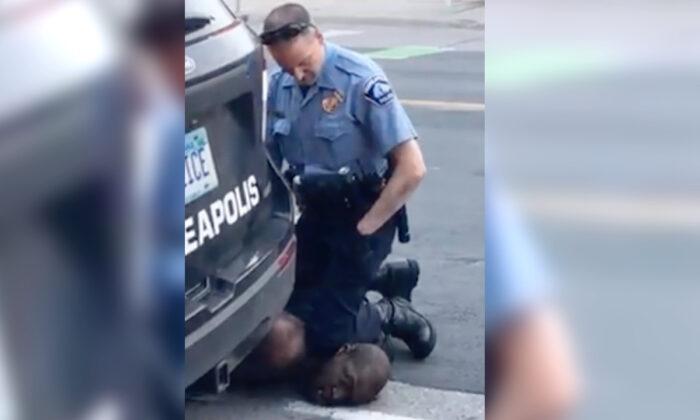MINNEAPOLIS—A local medical examiner from Hennepin County in downtown Minneapolis on Monday classified George Floyd’s death as a homicide, saying his heart stopped as police restrained him and suppressed his neck, in a widely seen video that has sparked protests across the nation.
Under “other significant conditions” it said Floyd suffered from heart disease and hypertension, and listed fentanyl intoxication and recent methamphetamine use.
A Minneapolis police officer has been charged with third-degree murder in Floyd’s death, and three other officers were fired. Bystander video showed the officer, Derek Chauvin, holding his knee on Floyd’s neck despite the man’s cries that he can’t breathe until he eventually stopped moving.
An autopsy commissioned for Floyd’s family found that he died of asphyxiation due to neck and back compression, the family’s attorneys said Monday.
The autopsy by a doctor who also examined Eric Garner’s body found the compression cut off blood to Floyd’s brain, and that the pressure of other officers’ knees on his back made it impossible for him to breathe, attorney Ben Crump said. He called for the third-degree murder charge against Officer Derek Chauvin to be upgraded to first-degree murder and for three other officers to be charged.

The family’s autopsy differs from the official autopsy as described in a criminal complaint against the officer. That autopsy included the effects of being restrained, along with underlying health issues and potential intoxicants in Floyd’s system, but also said it found nothing “to support a diagnosis of traumatic asphyxia or strangulation.” The family’s autopsy found no evidence of heart disease and concluded he had been healthy.
Floyd, a man who was in handcuffs at the time, died after Chauvin ignored bystander shouts to get off him and Floyd’s cries that he couldn’t breathe. His death sparked days of protests in Minneapolis and around America.

The official autopsy last week provided no details about intoxicants. In the 911 call that drew police, the caller described the man suspected of paying with counterfeit money as “awfully drunk and he’s not in control of himself.”
Crump said last week that he was commissioning the family’s own autopsy. Floyd’s family wanted an independent look because they didn’t trust local authorities to produce an unbiased autopsy.
The family’s autopsy was conducted by Michael Baden and Allecia Wilson. Baden is the former chief medical examiner of New York City, who was hired to conduct an autopsy of Eric Garner, a man who died in 2014 after New York police placed him in a chokehold and he pleaded that he could not breathe.
Baden also conducted an independent autopsy of Michael Brown, an 18-year-old shot by police in Ferguson, Missouri. He said Brown’s autopsy, requested by the teen’s family, didn’t reveal signs of a struggle, casting doubt on a claim by police that a struggle between Brown and the officer led to the shooting.
Chauvin, who was also charged with manslaughter, is being held in a state prison. The other three officers on scene, like Chauvin, were fired the day after the incident but have not been charged.

The head of the Minneapolis police union said in a letter to members that the officers were fired without due process and labor attorneys are fighting for their jobs. Lt. Bob Kroll, the union president, also criticized city leadership, saying a lack of support is to blame for the days of sometimes violent protests.
When asked to respond, Mayor Jacob Frey said Kroll’s opposition to reform and lack of empathy for the community has undermined trust in the police.
Gov. Tim Walz announced Sunday that Attorney General Keith Ellison would take the lead in any prosecutions in Floyd’s death.





